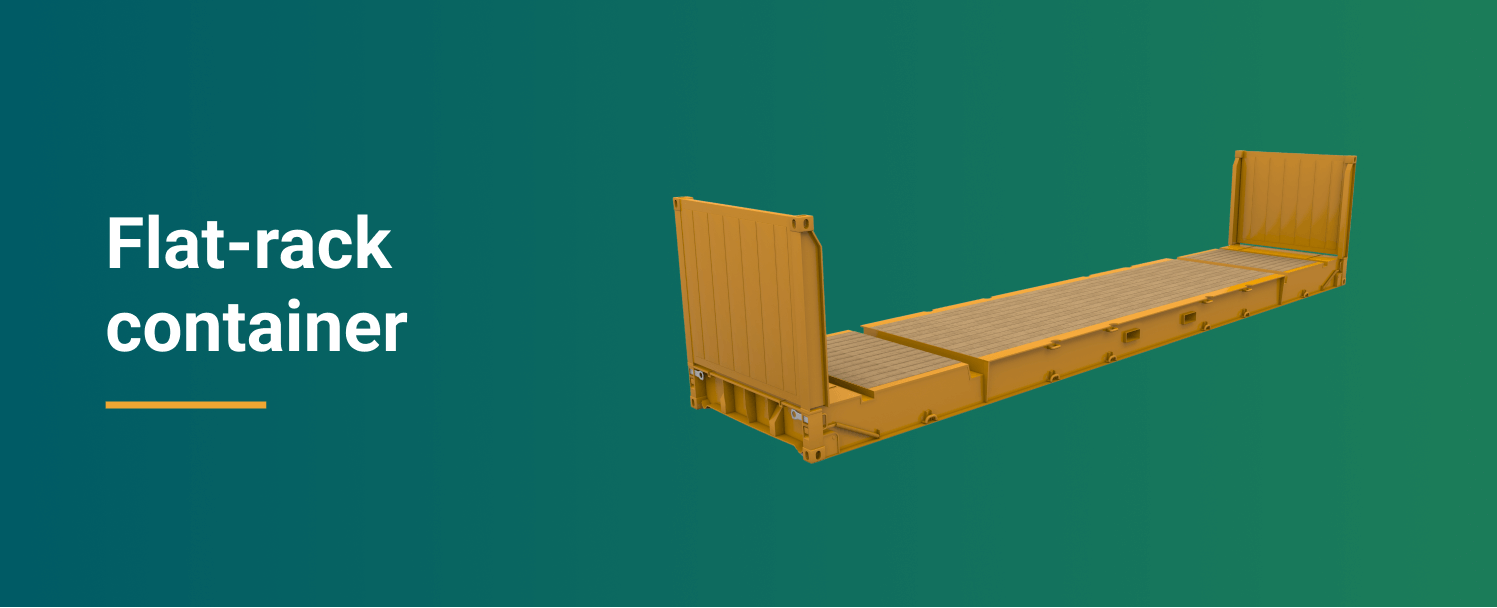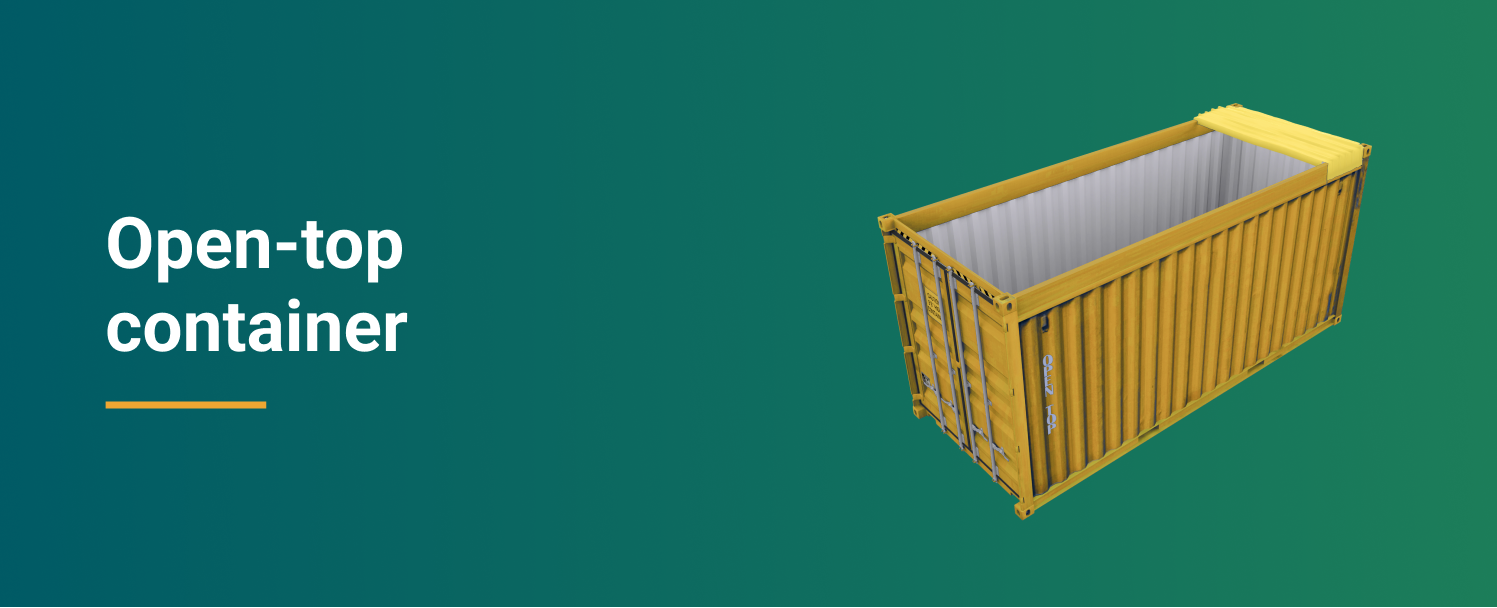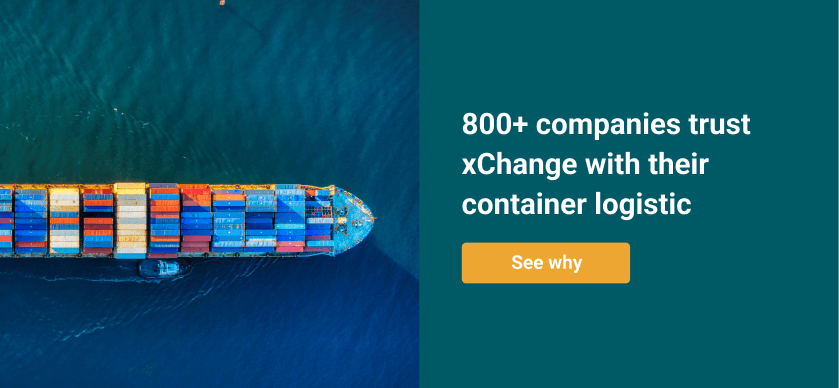Do you think about how efficiently you can use a container while shipping goods for your business? Because we can help with that. If you’re doing business in logistics, you understand how tough it truly is to move your cargo across stretches via sea freight. And at some point, a thought like “Am I utilizing the space in the box productively?” might cross your mind. That’s where you can start considering a floor loaded container.
Understanding a floor loaded container might be a little complex. This is because there are chances that you confuse it with an actual container type. Whereas, in reality – it’s a method to stack your containers from the ground up to the top.
Let’s delve into the details with this piece and see what a floor loaded container is all about.
What is a floor loaded container?
If you’re thinking about the significance of a floor loaded container, it’s exactly what it sounds like. It’s a container with the cargo loaded onto the floor. This type of container is used for shipping small and manageable cargo that’s put directly in the box without using pallets.
In a floor loaded container, the cargo is feasibly stacked, such as cars, machinery, or industrial equipment. Floor loaded containers typically have reinforced floors to support the cargo. And it may also have special features such as tie-down points or wheel chocks to prevent the cargo from shifting during transit. Floor loaded containers aren’t suitable for all types of cargo. They can be an ideal solution for you if you’re certain of your container needs.
Types that can be floor loaded
There are three main types of shipping containers that are frequently floor loaded – dry vans, refrigerated vans, and flatbeds.
- Dry vans are the most common type of container and are used to transport non-perishable goods.
- Refrigerated vans are used to transport perishable goods, such as food and flowers, that need to be kept cool.
- Flatbeds are used to transport large or bulky items that can’t be stacked, such as cars or machinery.
- Each type of container has its own unique features and benefits, and choosing the right type of container is essential for ensuring your goods arrive safely at their destination.
Floor loaded container v/s palletized container
The floor-loaded container is the most common type of container used in international shipping. As the name suggests, these containers are loaded from the floor up, with the goods being stacked directly on top of each other. Floor-loaded containers have a number of advantages over palletized containers.
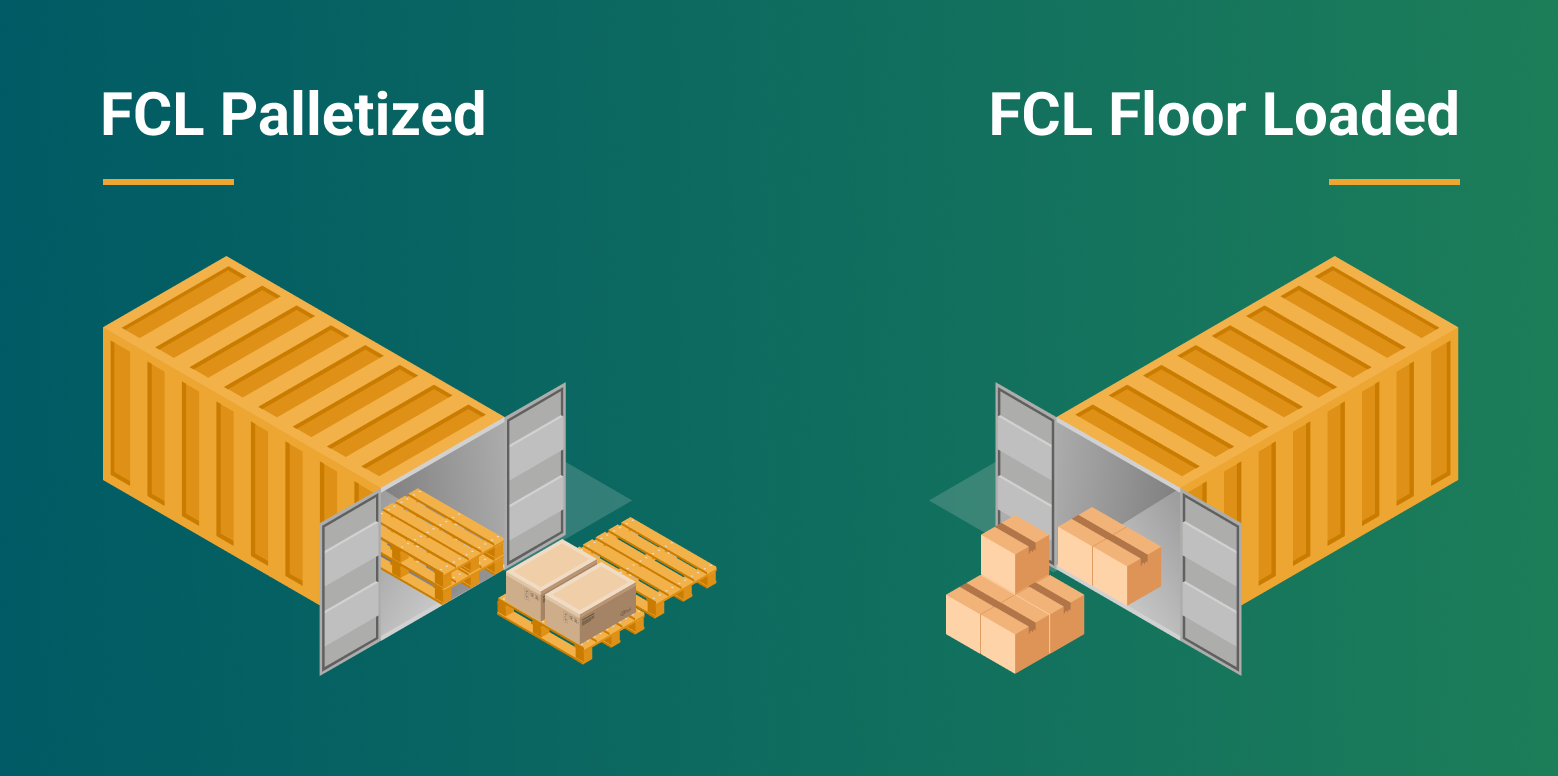
Floor loaded containers:
- Are easier to load and unload, since there’s no need to raise and lower pallets.
- Tend to be more stable during transport, since the weight is evenly distributed across the entire bottom surface of the container.
- Can be more efficiently packed, since there’s no wasted space between pallets.
Palletized containers, on the other hand, are loaded from the top down, with each row of goods being placed on a pallet.
Palletized containers have a number of advantages too. These boxes:
- Offer protection for goods during transit, since each pallet can be individually wrapped and/or padded.
- Are easier to unload using forklifts or other machinery, since the pallets can be quickly removed from the top of the container.
Choosing between the two can be difficult so it’s important for you to understand what type of cargo you’re shipping to make a choice. Once you’ve made your choice and you’re certain about picking a floor loaded container – the next question arises: what’s the right way to floor-load a container? Here’s how…
Right way to floor load a container
When it comes to stacking a floor-loaded container, there are a few things you need to keep in mind in order to do it correctly.
First, relatively heavier packages should be placed on the bottom. This will help ensure that the container is balanced and that the packages on top aren’t at risk of toppling over.
Next, lighter packages should be stacked on top. This will help prevent the packages on the bottom from being crushed.
Finally, bars and straps should be used to secure the packages in place. This will help to prevent shifting during transport and will also help distribute the weight evenly.
By following these simple tips, you can be sure that your floor-loaded container is stacked correctly and safely. But what all can you stack in a floor loaded container? Is it meant for vehicles, machinery, apparel, either one of them or neither of them? – Let’s find out, keep reading.
When to use a floor loaded container and what cargo to load
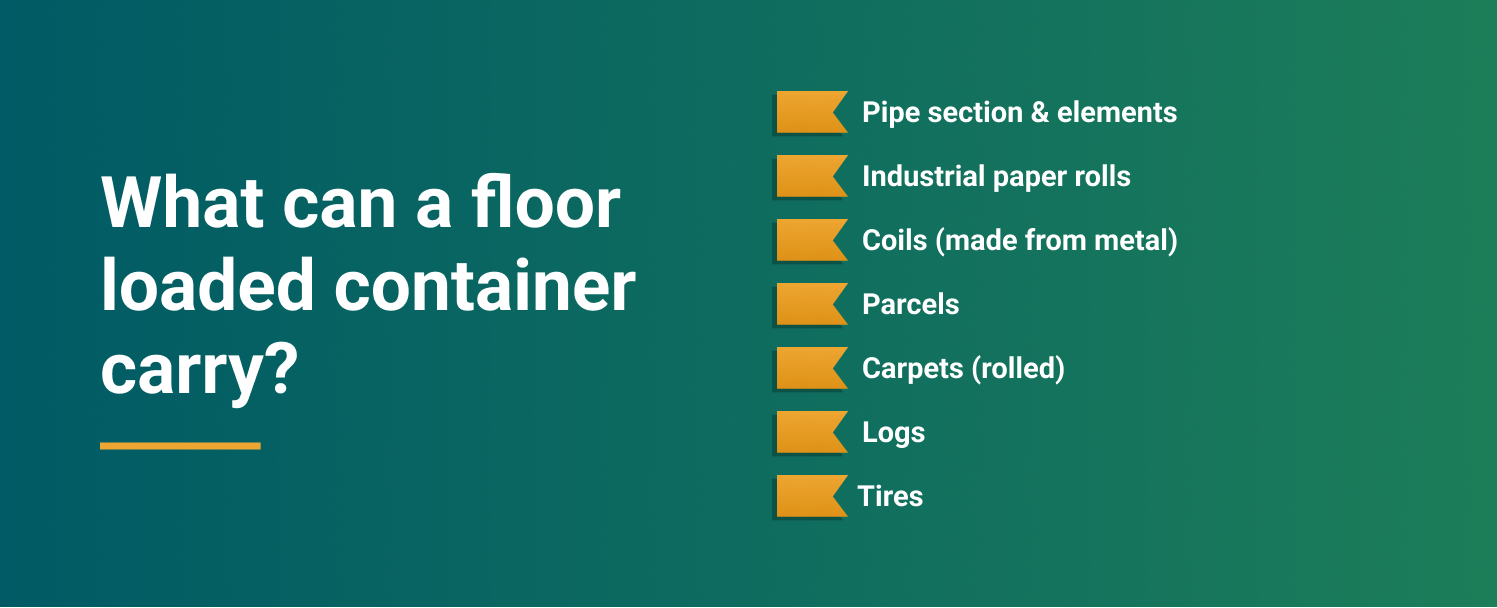
There are a number of different types of freight that are typically floor loaded due to their size, perceived durability, and individual shipping requirements.
Tires, for example, are typically made to be tough and resilient, able to withstand a great deal of wear and tear. As a result, they’re often shipped on the floor of a truck or train to prevent them from being damaged in transit. Parcels and rolled carpets are also frequently floor loaded due to the risk of damage if they were to be stacked on top of one another. Metal coils and industrial rolls of paper are often floor loaded for similar reasons.
Logs and concrete pipe sections are typically floor loaded because they’re too large and unwieldy to be stacked on top of one another. Intermodal and sea shipment containers that arrive from overseas are often floor loaded because they need to be unloaded quickly and efficiently.
Consequently, a variety of factors can contribute to the decision to floor load certain types of freight.
When loading a floor-loaded container, it’s important to distribute the weight evenly to avoid tipping or toppling. The only catch is that the items should also be securely packed so that they do not shift during transport.
Advantages a floor loaded container
A floor loaded container offers many advantages over the traditional ones.
One advantage is that it allows for more efficient loading and unloading of goods. This type of method also provides better protection for the goods during transportation, as the chances of damage in transit are less likely.
In addition, floor loaded containers offer greater security for the contents, as they’re more difficult to break into. Finally, this type of container is more versatile and can carry a variety of different types of shipments. As a result, the floor loaded container is an ideal option for many businesses.
When dealing with floor loaded containers, the use of forklifts is not a necessity to load or unload the goods. This saves time during the process, as well as protects the goods from any damage if they were dropped while being loaded onto the container.
Floor loaded containers can be easily stacked on top of each other, which helps to save space. Floor loaded containers are also less likely to tip over than other types of containers, which makes them safer to use.
Overall, floor loaded containers have many advantages over other types of containers, making them a good choice for a storage shipping container.
Although it has numerous pros to it, however, it does have its own edges as well. Some of the cons of a floor loaded container include:
Disadvantages of a floor loaded container
One downside to floor loaded containers is that since you distribute the weight of the goods across the entire floor of the container it sometimes gets a bit harder to lift.
Additionally, floor loaded containers are more likely to tip over during loading or unloading onto a ship. This can damage the goods inside.
Finally, these containers aren’t the best option for carrying heavy or fragile items, as the weight can cause the floor to buckle or break. For these reasons, floor loaded containers are best for carrying lighter goods that will not be damaged by tipping.
However, these containers are still very popular amongst businesses and have different types of boxes available for floor loading. Some of these types are as below.
Other container types on Container xChange
Container xChange is an online marketplace that helps you to ship, trade, lease, or buy containers. From providing you with a safe space to crack hot deals to managing your payments and networking with big players in the logistics industry, we aid you in expanding your business.
We, at Container xChange, help you choose from a variety of containers – depending upon your need. Some of the standard boxes popular among people are 40ft high cube container, 20ft DC and 40ft DC.
On xChange, you’ll also find special container types. So if you need a container for temperature-sensitive goods or to fit heavy cargo, keep scrolling and find out which special box should be your first choice.
Flat rack container
A flat rack container is a type of intermodal container used for shipping heavy or bulky cargo that is unable to be stacked. Flat rack containers have no sides or roof but have two or four collapsible legs.
These containers can ship awkward-shape items such as machinery, lumber, and other construction materials. When not in use, you can collapse a flat rack container, which saves on space and makes them easier to transport.
Open-top container
Open top containers are used for a variety of purposes. They can be used to store and transport goods.
They come in a variety of sizes and shapes and can be made from different materials, such as plastic, metal, or wood. Some open top containers have lids, while others do not. Open top containers are typically easy to use.
Reefer container
A reefer is a refrigerated container used to transport perishable goods. Reefer containers come with refrigeration units that are set to specific temperatures, allowing them to maintain the freshness of perishable goods during transit. Common items that you can transport in reefer containers include fruits and vegetables, meat and seafood, pharmaceuticals, and flowers.
Reefer containers can also transport non-perishable goods that require temperature-controlled storage, such as chemicals and electronic components.
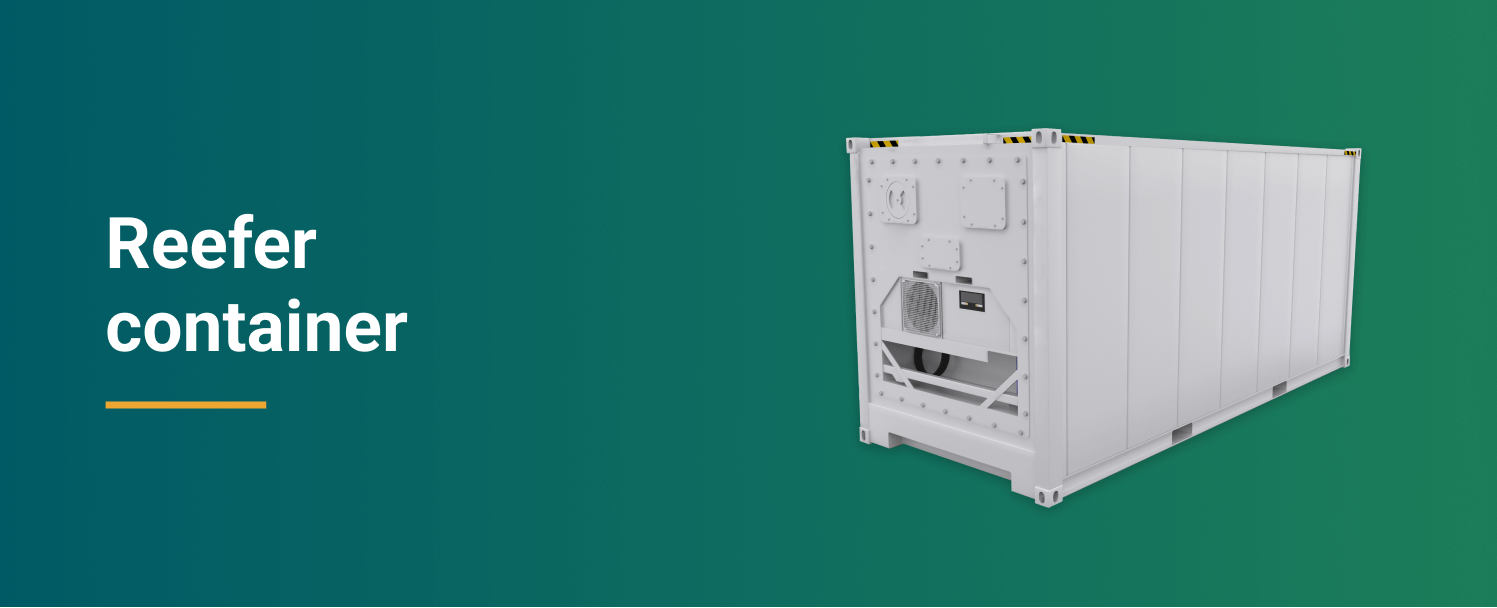
Container xChange helps you to buy your box without any hassle
If you’re you in business worrying about:
- How will you find a box to floor-load or palletize to stack your cargo
- Putting your trust into names that you hardly know
- Overpaying for your boxes
- Underselling your containers
- Tracking your shipping containers
- Maintaining transparency with your cargo carrier
Container xChange has got you covered. All you need to do is connect with us to join xChange’s community and pick a membership plan that works for you.
Once you’ve picked a plan, you’ll undergo a vetting process before we add you to our list of 1,000+ members from across the globe. With over 10,000+ boxes for you to choose from and secure names to seal deals with – we strive to cater to resolve all your container-related queries and expectations.
With over 10,000+ transactions every month, we have an established presence across 2,500+ locations. Our connectivity across international waters has helped us stay our customers’ first choice. And we intend to maintain that in the near future by expanding our list of features and services without compromising the quality of the product and the credibility of Container xChange.
Offering buyer’s protection alongside perks like trading at zero commission, unlimited deals at competitive prices, and payment handling feature as per your needs, Container xChange is all set to help you scale your business. You can sail seamlessly in the world of container shipping as we keep you updated with the industry news, the latest monthly reports to navigate the current market scape, and 24/7 customer support to resolve your queries.
What do you mean by a floor loaded container?
A floor loaded container means uniquely stacking a box with all the freight on the floor - without making use of the pallets.
How to know the difference between floor loaded & palletized containers?
Floor-loaded containers are filled with goods stacked to the ceiling. In palletized loading, the products are loaded on a pallet and tied with plastic wrap or metal straps to create a single unit.
What do you mean by floor loading in the shipping industry?
Floor loading has a number of advantages over other methods of packing. First, Floor loading container is placed straight on the floor without pallets. It maximizes the use of space, allowing more products to be shipped in a single container.



